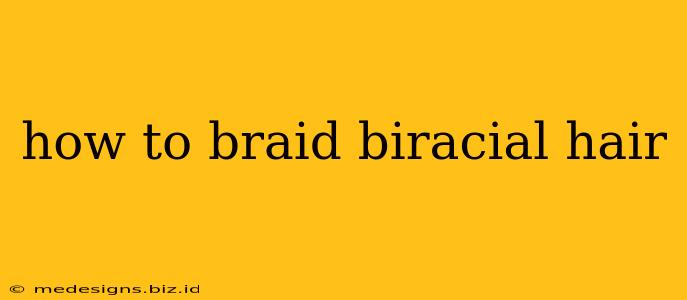Biracial hair, often a beautiful blend of textures, presents unique braiding challenges and opportunities. Whether your hair is predominantly straight, curly, kinky, or a mix, mastering the art of braiding can unlock stunning styles and promote healthy hair growth. This guide will equip you with the knowledge and techniques to confidently braid your biracial hair.
Understanding Biracial Hair Textures
Before diving into braiding techniques, it's crucial to understand the diverse textures that can be present in biracial hair. This often includes combinations of:
- Straight hair: Smooth and sleek, requiring different techniques than curlier hair types.
- Wavy hair: Has an S-shaped pattern, offering a unique texture for braiding.
- Curly hair: Forms defined curls or coils, ranging from loose waves to tight ringlets.
- Kinky hair: Characterized by tight, densely packed coils.
Understanding your specific hair texture mix will inform your choice of braiding style and techniques.
Essential Tools for Braiding Biracial Hair
Having the right tools is paramount for a successful braiding experience. Here's what you'll need:
- Wide-tooth comb: Gently detangles hair without causing breakage.
- Rat-tail comb: Creates precise sections for neat braids.
- Hair ties: Secure braids and keep them in place.
- Hair clips: Keep sections separated while braiding.
- Braiding gel or cream: Provides hold and prevents frizz.
- Hair oil (e.g., coconut, argan): Moisturizes and adds shine.
Pro Tip: Consider using products specifically formulated for your hair type (e.g., curly, coily, or mixed texture hair).
Basic Braiding Techniques for Biracial Hair
The fundamental braiding techniques can be adapted for various biracial hair textures. Here are a few to start with:
1. The Classic Three-Strand Braid:
This is the foundation of most braids. Practice this technique on small sections to master it before tackling larger braids. Remember to keep the tension consistent for a neat braid.
2. French Braid:
A more advanced braid that incorporates new strands of hair as you braid downwards. This works well for longer hair and can create an elegant, sophisticated look.
3. Dutch Braid:
Similar to the French braid, but the strands are crossed under instead of over, creating a raised, textured braid.
4. Fishtail Braid:
This intricate braid involves taking small strands from the outer edges of the hair and crossing them over to the center. It looks beautiful on medium to long hair.
Advanced Braiding Styles for Biracial Hair
Once you've mastered the basics, explore more complex styles like:
- Cornrows: Close-to-the-scalp braids that can be styled in various patterns.
- Box Braids: Square-shaped braids that are often thicker and longer than cornrows.
- Individual Braids: Individual strands of hair braided separately.
- Tree Braids: A variation of individual braids where smaller braids are added to create a fuller look.
Remember to section your hair properly before starting any advanced braids for a cleaner result.
Maintaining Braided Biracial Hair
Proper care extends the life of your braids and keeps your hair healthy:
- Keep your scalp clean: Use a moisturizing scalp cleanser.
- Avoid tight braids: Prevent tension-related hair loss.
- Moisturize regularly: Use hair oils or leave-in conditioners.
- Protect your hair at night: Sleep on a satin pillowcase.
- Avoid excessive heat: Limit the use of heat styling tools.
Conclusion
Braiding biracial hair is a journey of discovery. Embrace your unique texture and experiment with different techniques and styles to find what works best for you. With patience, practice, and the right tools, you can achieve beautiful, healthy, and long-lasting braids. Remember to prioritize hair health and choose styles that won't damage your hair. Happy braiding!
